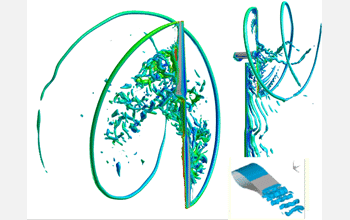Multimedia Gallery
Wind Turbine Simulation
Shown is a composite image of three simulations conducted as part of wind turbine advanced analsys research supported by the National Science Foundation (NSF). Clockwise from the left: (1) an isolated horizontal axis wind turbine (HAWT) in an upwind, zero yaw angle configuration; (2) complete configuration downwind HAWT, including with tower, nac elle and rotor; and (3) simulation of a flatback wind turbine rotor airfoil with semi-inifite span. In all three figures, an isosurface of the q-criterion is shown. This is a useful visualization method for identifing large-scale vortices, a significant source of turbine noise. All results were generated using the Large-Eddy Simulation (LES) software developed as part of this project. The simulation software is designed to predict the turbulent flow in the wake of the turbine and to ultimately predict the noise generated.
Methods to simulate a full wind turbine are being developed at the Georgia Institute of Technology and Computational Science & Engineering, LLC, with funding from NSF. These computer codes will help scientists and engineers understand and predict the complex turbulent wakes of wind turbines. Once developed, these methods will aid in the design of more efficient and quiet wind turbine designs to increase the use of wind energy as a viable sustainable energy resource in the United States.
[Research supported by NSF grant CBET 07-31034, "Advances in Wind Turbine Analysis and Design for Sustainable Energy;" professor Marilyn Smith (principal investigator). Computer resources were provided by TeraGrid at the NCSA, SDSC and TACC partner sites.] (Date of Image: March 2008)
Credit: Christopher P Stone, Computational Science & Engineering (LLC)
See other images like this on your iPhone or iPad download NSF Science Zone on the Apple App Store.
Images and other media in the National Science Foundation Multimedia Gallery are available for use in print and electronic material by NSF employees, members of the media, university staff, teachers and the general public. All media in the gallery are intended for personal, educational and nonprofit/non-commercial use only.
Images credited to the National Science Foundation, a federal agency, are in the public domain. The images were created by employees of the United States Government as part of their official duties or prepared by contractors as "works for hire" for NSF. You may freely use NSF-credited images and, at your discretion, credit NSF with a "Courtesy: National Science Foundation" notation.
Additional information about general usage can be found in Conditions.
Also Available:
Download the high-resolution JPG version of the image. (410 KB)
Use your mouse to right-click (Mac users may need to Ctrl-click) the link above and choose the option that will save the file or target to your computer.

